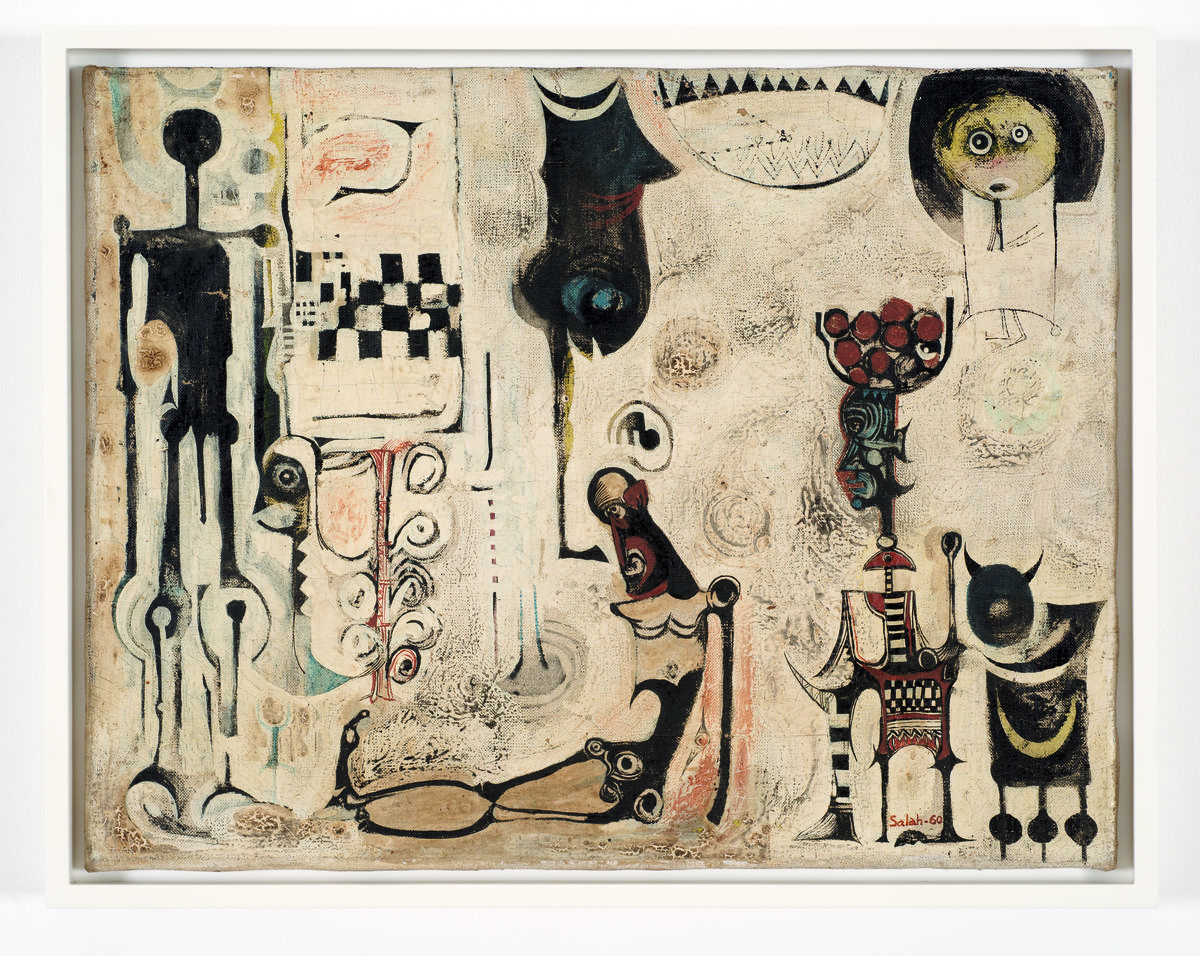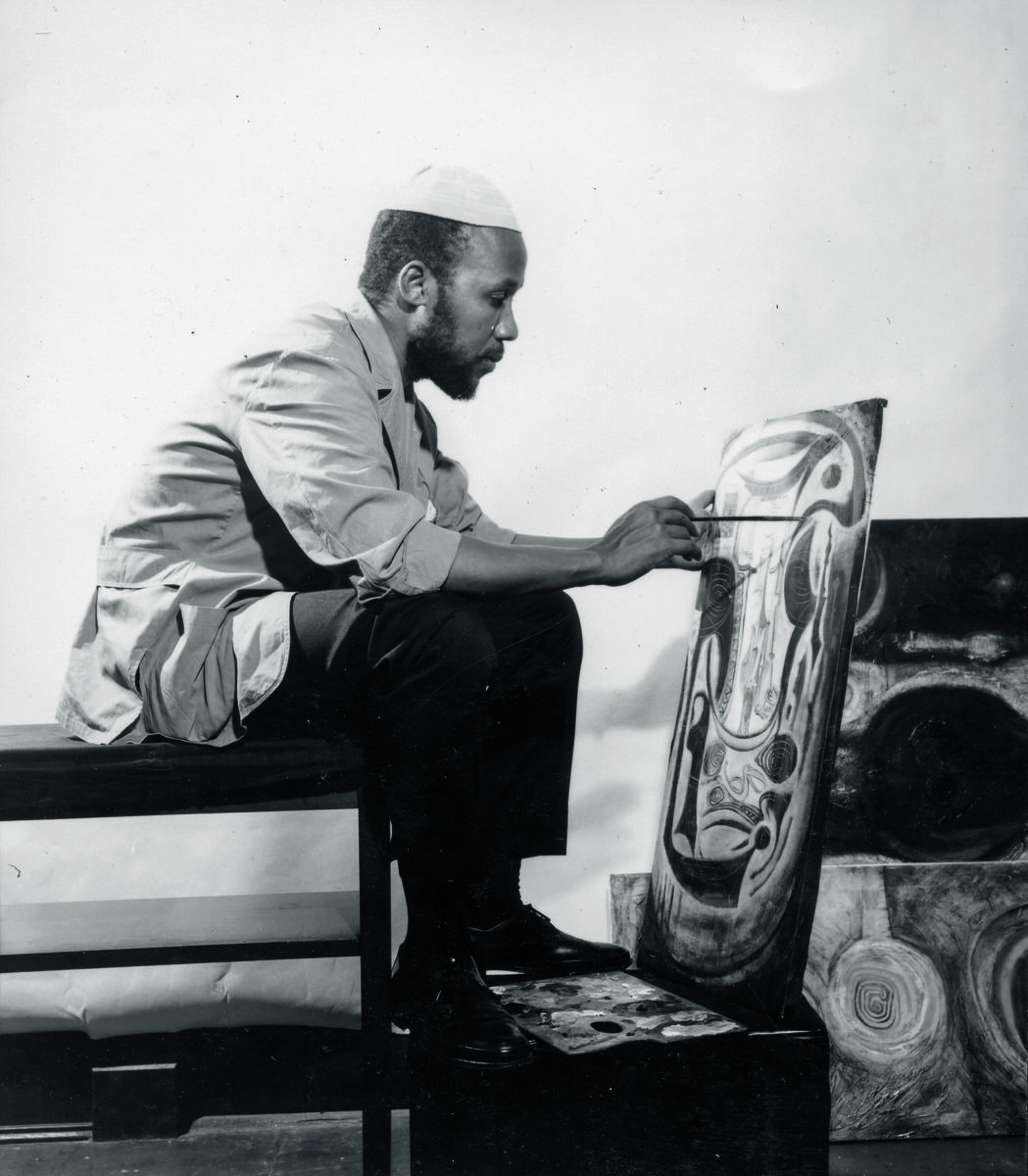Recent Acquisition | A Major Acquisition of African Modernism
 Ibrahim El-Salahi is one of Africa’s most celebrated postcolonial modernist artists, known for his contributions to calligraphic modernism. Born in Omdurman, Sudan, in 1930, El-Salahi studied Arabic calligraphy from a young age at the Qur'anic school run by his father from the family home. The artist moved to London in 1954 to study painting and calligraphy at the Slade School of Fine Art. There he supplemented the influence of teacher and painter William Coldstream’s observational realism with frequent trips to the British Museum and the Victoria & Albert Museum to examine their collections of Islamic art and through summer travels to Italy, where the Byzantine mosaics in Ravenna encouraged him to reorient his understanding of color and surface. In London El-Salahi was also exposed to Pan-African networks and anticolonial perspectives that impacted his approach to art making upon his return to Sudan in 1957, the year after the nation gained independence from British colonial rule. Alphabet No. 1 (1960) documents El-Salahi’s early experimentation with what the artist terms a “pictorial alphabet.” The painting displays motifs designed to resonate with audiences in Sudan, including skeletal figures with masked faces and prayer board torsos, birds, the crescent of a minaret, and the geometric patterning of Sudanese crafts. The artist began to incorporate such motifs into his visual lexicon only following his return to the country of his birth.
Ibrahim El-Salahi is one of Africa’s most celebrated postcolonial modernist artists, known for his contributions to calligraphic modernism. Born in Omdurman, Sudan, in 1930, El-Salahi studied Arabic calligraphy from a young age at the Qur'anic school run by his father from the family home. The artist moved to London in 1954 to study painting and calligraphy at the Slade School of Fine Art. There he supplemented the influence of teacher and painter William Coldstream’s observational realism with frequent trips to the British Museum and the Victoria & Albert Museum to examine their collections of Islamic art and through summer travels to Italy, where the Byzantine mosaics in Ravenna encouraged him to reorient his understanding of color and surface. In London El-Salahi was also exposed to Pan-African networks and anticolonial perspectives that impacted his approach to art making upon his return to Sudan in 1957, the year after the nation gained independence from British colonial rule. Alphabet No. 1 (1960) documents El-Salahi’s early experimentation with what the artist terms a “pictorial alphabet.” The painting displays motifs designed to resonate with audiences in Sudan, including skeletal figures with masked faces and prayer board torsos, birds, the crescent of a minaret, and the geometric patterning of Sudanese crafts. The artist began to incorporate such motifs into his visual lexicon only following his return to the country of his birth.
Back in Sudan, El-Salahi began to teach painting at the School of Fine and Applied Arts in Khartoum, where he was a founding member of the Khartoum School. His disappointment in the reception among Sudanese audiences of the work he had produced at the Slade School motivated the shift in his practice. He started creating work that explored the design, color, and subjects of everyday life in Sudan, limiting his palette to hues evocative of the Sudanese landscape—the black, white, burnt sienna, and yellow ocher seen in Alphabet No. 1. He saw the local arts, crafts, and culture anew, and he traveled across Sudan to observe and draw the patterns adorning homes and domestic items—such as saddles and prayer carpets—in addition to sharafa, calligraphic decorations honoring the Qur'an. He recalled in a 1967 interview, “And suddenly I think that the beauty of it came to me and hit me—it’s so strong. I lived with it all my life and yet I never saw it before, until I went outside and came back, with a different outlook towards things.”
 In Alphabet No. 1, El-Salahi grapples with the tension between narrative figuration and abstraction, which led to the calligraphic modernism for which he became known in the 1960s. Alongside his examination of Sudanese crafts, El-Salahi began to analyze Arabic calligraphy. He incorporated legible letters and words, but not necessarily their meanings, into his compositions; he became interested in the letters as rhythmic forms that he disassembled and reconstituted into a new visual language. From his careful study of Arabic’s calligraphic script, figures and images emerged from the spaces in between letters, and geometric designs receded into the background. In the brochure for El-Salahi’s 1962 exhibition at Galerie Lambert in Paris, where Alphabet No. 1 was on view, the Guyanese artist and art historian Denis Williams described El-Salahi’s paintings from this time as “unfinished phrases.” He noted, “The line appears, disappears, reveals an image, fragmentary and of terrific power, then wanders off into the shadow.”
In Alphabet No. 1, El-Salahi grapples with the tension between narrative figuration and abstraction, which led to the calligraphic modernism for which he became known in the 1960s. Alongside his examination of Sudanese crafts, El-Salahi began to analyze Arabic calligraphy. He incorporated legible letters and words, but not necessarily their meanings, into his compositions; he became interested in the letters as rhythmic forms that he disassembled and reconstituted into a new visual language. From his careful study of Arabic’s calligraphic script, figures and images emerged from the spaces in between letters, and geometric designs receded into the background. In the brochure for El-Salahi’s 1962 exhibition at Galerie Lambert in Paris, where Alphabet No. 1 was on view, the Guyanese artist and art historian Denis Williams described El-Salahi’s paintings from this time as “unfinished phrases.” He noted, “The line appears, disappears, reveals an image, fragmentary and of terrific power, then wanders off into the shadow.”
Arabic calligraphic script created positive and negative spaces that revealed a world of imagery to El-Salahi. He wrote, “In place of those broken-up letters, I discovered animal and plant forms, sounds, human images, and what looked like skeletons with masked faces.” The formal complexity of the artist’s paintings arises from his rigorous analysis and experimental integration of Arabic, alongside both Sudanese and global forms and iconographies. El-Salahi’s investigations into his heritage through his art also link his work to the practices of postcolonial modernist artists working throughout Africa in the independence era of the 1950s and 1960s. The art historian Chika Okeke-Agulu has written about these artists’ “search deep within themselves or their native cultures for ways to invent a new aesthetic that meaningfully reflected their new identities as radically self-aware postcolonial African artists.” Exposed to the rhetoric of political decolonization through their movement in Pan-African intellectual circles, artists like El-Salahi invented new and radical formal styles through artworks like Alphabet No. 1 to meet an era of transformative cultural and political change.
Perrin Lathrop
Assistant Curator of African Art